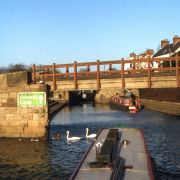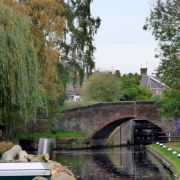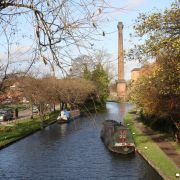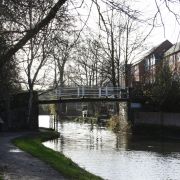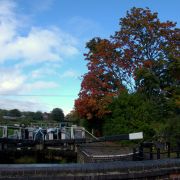Visit the Erewash Canal
Padmore moorings Sandiacre
The Erewash Canal
If you would like to moor at Langley Mill at the top of the Erewash canal check our moorings page
The Erewash canal meanders along the Erewash valley from Trent Lock to Langley Mill. I have listed the relevant bridge numbers, road names and road numbers between locks where road access is possible (exceptions are marked**). The accompanying photographs show the 14 locks from Trent Junction to Langley Mill, they are numbered and named as follows:
- 60 - Trent lock
- Bridge 3 Tamworth Road B6540
- 61 - Long Eaton lock
- Bridge 6 Derby Road B6005
- 62 - Dockholme lock
- 63 - Sandiacre lock
- Bridge 9 Brian Clough Way A52 ** no road access to canal
- Bridge 10 Derby Road Sandiacre B5010
- 64 - Pasture lock
- Bridge 13 Stanton Gate
- Bridge 13A M1 **
- 65 - Stanton lock -*originally named Whitehouse Junction lock
- 66 - Hallam Fields lock
- Bridge 16 Hallam Fields Road
- Bridge 17 Nottingham Road A609
- 67 - Gallows Inn lock
- 68 - Greens lock -*originally named Sough lock
- Bridge 18 Green Lane
- Bridge 19 Potters bridge Monks Close
- 69 - Potters lock -*originally named Ilkeston Mill lock
- Bridge 20 Station Road Ilkeston
- Bridge 22 Awsworth Road
- 70 - Barkers lock -*originally named Ilkeston Common Bottom lock
- 71 - Stenson's lock -*originally named Ilkeston Common Top lock
- Bennerley Viaduct **
- Bridge 23 Bridge Street Cotmanhay
- Bridge 25 Shipley Road bridge Long Lane
- 72 - Shipley lock
- 73 - Eastwood lock
- Bridge 27 Anchor Lane
- Bridge 28 Derby Road A608 Langley Mill
- Langley Bridge Lock - Cromford Canal
* denotes a change of name during the 20th century.
** denotes - no road access to canal
Maximum boat dimensions
- Length 80 foot 4 inches | Width 13 foot 5 inches
- Draught 4 foot 0 inches | Headroom 7 foot 4 inches
Note: Width and Headroom measured at Hallam Fields bridge
History of the Erewash Canal
In 1776 an act was passed authorising the construction of a navigation from the junction of the rivers Soar and Trent to Loughborough. This prompted a group of landowners and businessmen from Derbyshire to explore the possibilities of a canal linking the Derbyshire coalfields to the River Trent.
This proposed canal would link Derbyshire and Nottinghamshire to other Midlands counties and on to London. John Smith (formerly apprenticed to William Wyatt) surveyed the area from the river Trent to Langley Mill. The canal would run from here and emerge opposite the river Soar at a junction now known as Trent lock
Building the Erewash Canal
By April 1777 the building of the Erewash Canal was authorised by an Act of Parliament. John Varley was appointed as the engineer with John and James Pinkerton as the main contractors. John Varley was later sacked for miscalculating water levels.
Two years later in April 1779, the canal was navigable from Trent Lock to Ilkeston Common and during December 1779 the canal was completed. It is 11.75 miles long with a rise of around 110 feet and has 14 broad locks.
The canal connected coal mines around the Erewash Valley to the Loughborough Navigation and then by road to Leicester and elsewhere. Other products carried included pottery, textiles, and iron. The Erewash Canal was joined along its length by several other canals: the Cromford (1794), and the Nottingham (1796), the Nutbrook (1795), and the Derby (1796).
Joining the Derby Canal
A tollhouse was built in 1797 adjoining the Sandiacre lengthsman's cottage to serve both the Erewash and Derby canals. The Erewash Canal was a commercial success from the start, mainly transporting coal.
Around 1847 the Cromford Canal Company decided to sell out to the encroaching railways, although it took five years to complete a deal. By 1855 the Nottingham Canal had also sold out to the railways causing a further decline in boat traffic on the Erewash Canal.
Decline of boat traffic
Fifteen years later in 1870, the tonnage of goods transported from the Cromford Canal had fallen to less than 50% of what it was before they had sold out to the railways. Moving on another 18 years to 1888 and the tonnage carried from the Cromford Canal had dropped to just 15% of its pre-railway level.
One year later in 1889, the Erewash Canal saw a further sudden loss of income when the Butterley Tunnel on the Cromford Canal was closed due to a rockfall. It was closed for several years and the lost trade never returned.
By 1894 the Grand Junction Canal bought out the waterways linking their canal to Leicester. Their plan was to run the whole coal route between the East Midlands and London. The Erewash Canal (along with the companies running the River Soar Navigation) made an agreement with the Grand Junction company that tolls would be lowered on the promise of a guarantee from the Grand Junction Canal if profit levels were not maintained.
One hundred years after it opened, the top three miles of the privately-owned Nutbrook Canal were closed in 1895 and the Grand Junction Canal ended up having to pay out on the guarantees it had promised. The first mile of the Nutbrook Canal was kept open and served the Stanton Ironworks well into the 1900s.
1900 and Butterley Tunnel on the Cromford Canal had to be closed for a second time when another rockfall blocked the tunnel. The canal’s owners refused to repair the tunnel and the (already) small amount of trade that came to the Erewash Canal from Cromford was now completely lost. For several years the Erewash company supported efforts by traders on the Cromford Canal to force its owners to repair Butterley Tunnel. However, in 1907 a further collapse in the Butterley tunnel in February of that year ended all hopes that it would be repaired.
In 1909 the Butterley Tunnel was finally pronounced beyond economic repair by a Royal Commission.
In 1932 the Erewash Canal was purchased by the Grand Union Canal Company. During World War 2 it was used to carry bombshells from Stanton Iron Works and it was due to the ironworks that the canal remained viable for so long.
Nationalisation came in 1947, by then the loss of trade due to competition from other forms of transport was having a great effect and the last commercial narrowboat operation was in 1952.
Closure of the canal
Ten years later in 1962, the Erewash Canal was officially closed to navigation above Gallows Inn Lock as it was classified as a 'remainder' waterway. Therefore due to lack of boat navigation this section silted up and became increasingly difficult to navigate with a boat. In 1967 a Government White Paper proposed that most of the Erewash Canal should be closed.
Local newspaper report
Below is a copy of a local newspaper article printed in the Long Eaton Advertiser on Friday 22 September 1967. (Source British Newspaper Archives)
"The proposal made in a Government White Paper not to include most of the length of the Erewash canal in the list of waterways to be kept open has provoked strong comment from one Long Eaton canal user. Mr. D. J. Alsop. of 2. Sandown-road. Toton who is the owner of the pleasure cruiser "Erewash Princess" which makes trips between Sandiacre and Long Eaton along the canal says that this will result in the formation of a "stagnant pool of water which inside a year will fill with rubbish, and weeds. "It will be worse than a town tip". Mr Alsop uses the canal every week and he said that even now it gets full of old bicycles and scrap. Mr. Alsop also said that in the stretch of canal between Dockholme dock and Long Eaton, especially behind the houses along Bennett Street, the results of this would be particularly bad and unhealthy for inhabitants. If approved the closure will probably come into operation during the spring or early summer of next year. "We must act now to get anything done" said Mr. Alsop.
FILLED IN
The canal has been used many years for boats travelling as far as Ilkeston, and although the stretch between Ilkeston and Langley Mill is officially unnavigable, smaller craft have been using it. If the canal is closed, it will be completely filled in at Tamworth-road, and other parts will be blocked by removing lock gates and replacing them with wooden planks, also reducing the water level."
Erewash Canal Action Committee
In January 1968, the Erewash Canal Action Committee (ECAC) was formed to combat the threatened closure of the Erewash Canal. At a subsequent meeting in February 1968, the Erewash Canal Preservation & Development Association (ECP&DA) was formed by the ECAC members. By this time Langley Bridge Lock was already being infilled along with Cromford Canal and Nottingham Canal Great Northern Basin above the lock.
The story of the Erewash Canal and the impact that the Erewash Canal Preservation & Development Association volunteers have made over the years continues on the ECP&DA page.
The Erewash Canal Locks
A series of photographs plotting your route through the locks from the River Trent or River Soar to Langley Mill Basin and the start of the Cromford Canal.
Facilities at Langley Mill for Boaters
